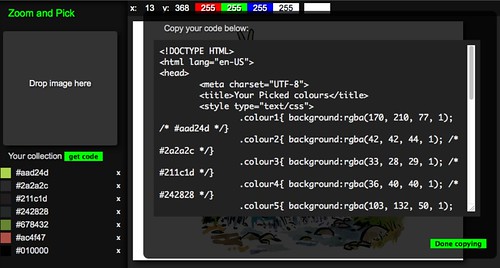Flash is not the enemy – our lack of focus on what is important is
Thursday, January 31st, 2013Yesterday I tweeted about The Procatinator, a web site that loads a random cat gif and music every time you click a button. Most people very just happy to get some damn good internets but one reply to me was sadly predictable:
@janl: @codepo8 please don’t link to flash BS.
Burn the witch! I dared to link to something that uses Flash. The same Pavlovian response happens every single time I embed a YouTube video into a blog post about HTML5. Flash is the enemy! How dare I fraternise with it?
Well, in the case of YouTube embeds, there is a reason: I was asked by quite a few people not to include my own hosted video files as they live in areas with slow connectivity and using the Flash embed gives them videos that are terrible quality, but viewable and skip/scan-able on their connections instead of downloading a relatively massive file.
Furthermore, the joke is on the people complaining about Flash YouTube videos, as I am using the iframe embed, which gives HTML5 video to those who opted into the HTML5 trial of YouTube. That someone who loves HTML5 that much that they need to complain everywhere it is isn’t used didn’t do that is unlikely. Or, more likely – they are trolls.
There is nothing “ironic” about using a tool that is widely used to talk about another techology, as eloquently explained in Jeffrey Zeldman’s rant on the subject.
But back to Procatinator. Procatinator is “Internet Whimsy” at its best.

It is there to make people laugh, waste a few minutes not answering emails angrily and has kittens and music. It already skirts on the illegal by using YouTube videos without showing them but playing them as music instead and the code shows that it was done as a fun project and nothing more. And you know what? That is fine. Important is the end result here, nobody gives a hoot about the technology used or the code quality. Nobody but us self-appointed defenders of the open.
If you want to reach as many people as possible, you use whatever works. This is why imgur is full of texts in JPGs without alternative text or text equivalents. These are easy to create and style and can be redistributed in every environment, including those that do not allow HTML like Facebook or Google+. Professional whimsy providers of the web of course also put up a text equivalent to get Google to index their site as a resource as Blame it on the voices shows.
Animated GIFs had a massive comeback last year. The reason is not that they are amazing quality or small in file size – the opposite is the case unless you really know what you are doing (pro-tip: perceptual colours, no dither, 10% lossy, drop those tween frames). The reason is that they are simple to produce and work everywhere that can display images.
So, Flash. Why is it not the enemy? It is closed and alien to the web, after all!
Without Flash, the web as a content distribution platform wouldn’t be where it is. There, I said it. And the reason is the Internet Whimsy we like to scoff about as “waste of time” and “amateur work”. Without Flash we wouldn’t have had Homestar runner, we wouldn’t have had Joe Cartoon and the famous Gerbil in a microwave, we wouldn’t have Weebl and Bob, we wouldn’t have played all the games on Newgrounds and many more.




I talked with this the last time I visited Rob, founder of b3ta.com and we chatted about my job. Rob is a producer of content, most of it Internet Whimsy but with a background of doing it professionally for professional content. And his main point was that Flash makes it damn easy to get something out there and it is all about that. The half-life of content on the web for him is much shorter than it is for me, the guy who cares about code and content quality above all. Using Flash and its tooling it is simple to create a quick animation with music and get it out there.
And this is what it boils down to: tooling! We shouldn’t complain about Flash being used, we should make sure we build tools that allows content makers to publish their work in open formats. Mozilla’s Webmaker initiative is all about that and Popcorn can be a great tool to make your first interactive open technology video using the familiar time-line interface of Flash. Even better, Adobe, the people behind Flash are working on tools to allow content creators to render them out as HTML5. If anybody knows what people who choose Flash need, it is them! Why don’t we as a self-appointed spokespeople of open tech promote and support these efforts instead of complaining about the use of Flash?
So what about Procatinator, does it really need Flash to work? Yes and no. Yesterday night I spent half an hour to create an HTML5 version of Procatinator using much simpler, plain JavaScript, CSS (using background-size instead of stretching the GIFs with jQuery) and using the YouTube IFRAME API and the YouTube Data API. I yet have to put in the permalinking option the real one has and the syncing is not as smooth as I don’t wait for the GIF to be loaded.
So hooray, Chris saved the day and opened what was closed! Rejoicing all around. The question we have to ask ourselves though is what we gained by that? The main reason why people complain about the use of Flash are:
- They have no Flash and don’t want it
- Accessibility concerns (in a lot of cases based on old information about Flash and assistive technology)
- It doesn’t work on iOS.
The latter being the real clincher. We are excited about our expensive Apple toys and are affronted if someone publishes their content in a format not digestible on our very closed platform. How dare they not support the thing “everybody has”?
Well, it turns out that the non-support in many cases is by design as iOS doesn’t make it easy to support it using open standards when it comes to audio and video.
In the case of Procatinator I told the makers that they could use the YouTube iframe API to ensure HTML5 support instead of a Flash dependency. Not so. The main issue is that Procatinator needs to start playing the song automatically, and in iOS any HTML5 media content needs to be activated by the user to start loading and playing. As the video in this case is not visible and just a background music provider and there is no “audio only” API for YouTube all my efforts didn’t make a difference. By design of the operating system our hands are tied. And, as developers, we should scream and complain about that – not about people using what works.
All in all, the big hurdles we need to jump when it comes to making the web open is not telling people off for using what they know. Our job is to provide the tools to make it the simple choice to use open technology and to create as many high-profile sites and products that point out that a lack of functionality is based on the platform not allowing it instead of the technology being insufficient.
What we have to avoid at all cost is bringing up a new dependency layer for end users. It is ridiculous to complain that Flash needs installing when we build “open HTML5 technology solutions” that only work in one browser or expect the end user to set a developer flag or download a nightly build. This is not about users being slow on the uptake, this is about us getting too excited about our toys. Let’s move our efforts and apply our knowledge to making it easy for people to use the open web. We are not in a position to demand anything from them, as if we do, we’ll lose them. Not to Flash, but to native technologies.
Discuss? Google+ thread and on Facebook




